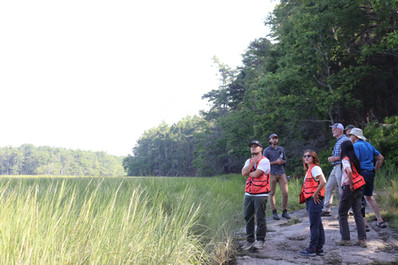Holt Research Forest Celebrates Productive Field Season
- Johnson, Light, Murray
- Aug 15
- 4 min read
Preparing the next generation of forest stewards is a key priority of Maine TREE Foundation. While most know of our work with teachers and students, we also provide hands-on work experience for young professionals. This summer, two research technicians, under the guidance of Research Manager Paulina Murray, collected long-term data of seeds, seedlings, saplings, and timber, contributing to more than 40 years of data collection efforts within the forest.
On Wednesday, August 6, members of Maine TREE’s Board of Directors, Holt Research Forest Committee, and staff visited HRF in Arrowsic, Maine, to celebrate a productive and successful 2025 field season and the successes of the two Summer Research Technicians, Ashton Groneman and Alex Klalo.

Ashton Groneman is headed into her senior year at the University of Maine, where she is majoring in Wildlife Ecology with a concentration in Management and a minor in Forest Ecosystems. Having grown up on a small family farm, she always knew she wanted to pursue a career outside. She particularly enjoys studying ecosystems from a multidisciplinary lens and has a specific interest in herps (reptiles and amphibians), birds, and forest and wetland ecology. She joined the Holt Research Forest crew looking to gain more exposure to the forestry industry and data analysis. She aspires to earn a Master’s degree and ultimately work as a state biologist or a consultant/researcher for a private organization or a nonprofit.
Alex Klalo, originally from New Jersey, recently graduated from Stockton University with a B.A. in Environmental Studies, with a concentration in Forestry, and previously earned a B.S. in Business Studies, with a concentration in Financial Planning. His goal while working with the Holt Research Forest was to learn more about what it takes to conduct research and to gain knowledge about the oak-pine ecosystem along the coast of Maine. Having previously worked at Barnegat Lighthouse State Park along the Jersey shore and as part of a conservation corps in western Colorado, he enjoys taking advantage of opportunities that allow him to explore new environments. He is currently looking for his next adventure, but is sure that wherever his career path may take him, it’ll be outside.
In addition to collecting data, both technicians conducted an independent research project utilizing existing Holt Research Forest datasets, which they presented to attendees.

Ashton’s project focused on a single warbler genus, Dendroica, found within Holt Research Forest, to determine how their abundance responded to the 1988 harvest Ashton hypothesized that the abundance of Dendroica warbler species would increase in response to the 1988 partial timber harvest and be higher in harvested blocks than in control blocks due to their specific habitat requirements, such as canopy gaps, edges, or early successional habitat. Utilizing Holt Bird Census 1983-1989, Ashton found that warbler abundance significantly decreased in 1988 and 1989 post-harvest, likely due to changes in habitat conditions, noting that Warbler habitat is varied and mature trees being used for nesting may have been removed, which could result in a delay of any positive effects. Data showed no significant difference between control and harvested blocks, implying that harvests affected the forest as a whole. When presenting, Ashton compared the harvest to home renovations, “if you are building a new sunroom in your house, you likely don’t want to be there until the work is done.” She finished her presentation by stating that she would be interested in seeing more years after the harvest or surveys around the 2020 harvest, which could provide a more thorough understanding of the impacts of harvest on warbler population density and distribution within the study area.

The Holt Research Forest does not have a definitive history of having fire on the property, but that does not necessarily mean that there can’t be in the future or has not been in the past. Given his experience in the New Jersey Pine Barrens, Alex’s project focused on how the 1988 timber harvest affected fire risk at Holt Research Forest, hypothesizing that the harvest would significantly impact wildfire risk and that unharvested blocks would increase in wildfire risk.” Alex usedTimber Inventory datasets from 1984 and 1988 to find a noticeable change in the harvested blocks. Overall, nine blocks changed to the low-risk category in 1988, after the harvest occurred, and only one block moved into the high category in 1988. He also noted that further information, such as tree species composition and woody debris, could be analyzed if time had allowed to create a more accurate estimate of the wildfire risk.
Both Ashton and Alex said that these projects gave them valuable experience using R Studio, an open-source programming platform often used in scientific data analysis. These projects also allowed them to conduct research based on their interests, utilizing real datasets.
After a brief refreshment break, many attendees joined the research team on a forest tour.
Notable stops included the research areas' four deer exclosures, which offered the opportunity to discuss research on how deer browse impacts Oak regeneration. Oak within Holt Research Forest is not only a favorite snack of deer but has also faced significant mortality in some areas due to defoliation caused by winter moth this summer, as well as oak leaf rolling weevil in previous summers.
While several important species are facing significant forest health impacts, robust regeneration of Eastern White Pine was seen throughout the recently harvested research blocks, and a notable number of spruce saplings were present within the forest despite being at the very southern edge of its range. The group also discussed how Holt Research Forest is positioned in a unique conservation landscape. The property has a conservation easement, held by the Nature Conservancy (TNC), which permanently protects it from development, and is neighbored by property owned by TNC to the north and across the Back River, and to the south by the Maine Department of Inland Fisheries & Wildlife.
Holt Research Forest is one of a kind, where continuous ecological monitoring of oak-pine forest ecosystems has occurred for over 40 years. In its history, it has provided over 100 summer interns, graduate students, and technicians the opportunity to contribute to meaningful research projects that influence how the forest is managed, and continues to serve as a launching pad for vibrant careers in Maine’s forests.
To learn more about Holt Research Forest or to view published datasets, visit www.mainetree.org/HRF
***Special thanks to Pete Johnson for sharing personal photos of the tour
.jpg)


















Comments